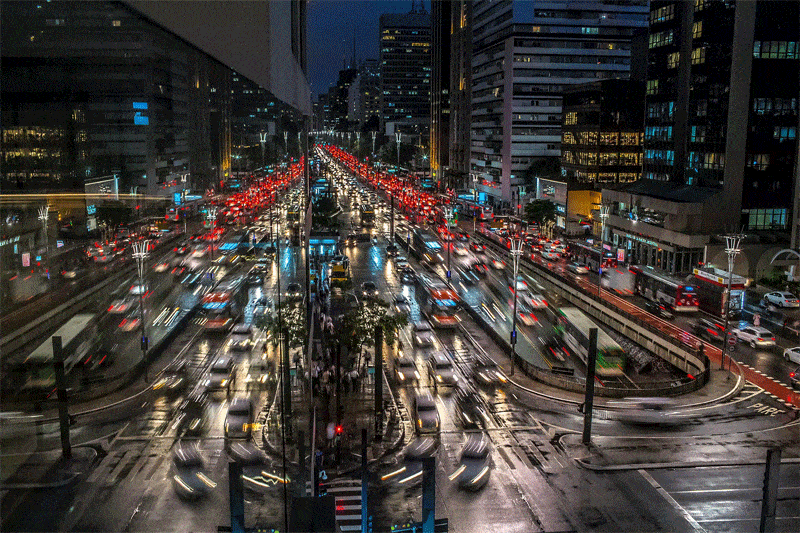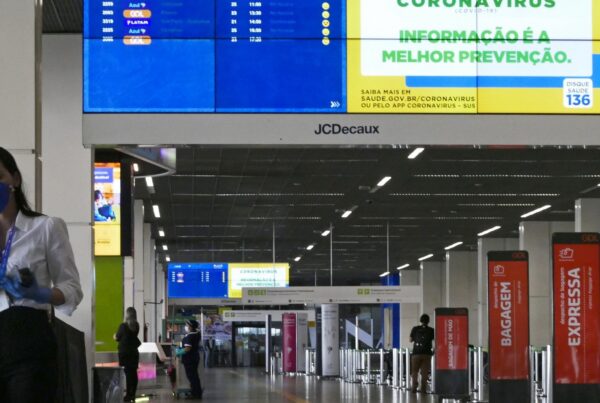Published by New York Times
36 Hours in São Paulo
The city’s treasures lie just below the surface: world-class restaurants, Brazil-class music and an ever-ebullient arts scene.

Chaotically refined, verdantly concrete, intimately gargantuan: The most populous metropolis in South America was but a middling coffee city until the mid-20th century, when an influx of northeastern migrants set off a growth spurt that shows no sign of stopping. With seemingly infinite skyscrapers nearly blocking out the sun (when its famously overcast skies don’t do it first), visitors don’t always take to the city instantly. But its treasures lie below the surface: world-class restaurants, Brazil-class music and an ever-ebullient arts scene, from alternative theaters to sparkling new museums. And though Paulistanos are often stereotyped as harried and overworked, that’s only compared to other Brazilians; compared to most megacity dwellers they are downright easygoing. Meanwhile, there’s ever more to see, as the slow-cooker of progress — or is it gentrification? — regenerates the once-abandoned historic center, block by block. But downtown is still no hipster paradise. It’s as vibrant and culturally alive as it is gritty and pickpockety, enough so that many wealthy residents stick to greener, wealthier areas. Visitors, of course, can take in the best of both. (Note: The United States Centers for Disease Control and Prevention is advising Americans headed for São Paulo to be vaccinated for yellow fever first.)
Friday
1) 3 P.M. DOWNTOWN ABBEY
Friday afternoon is the perfect time to explore the old center, when it is still humming with office workers streaming in and out of modest shops and restaurants. Plot out your destinations on a paper map beforehand, as cellphone-gazers attract skilled pickpockets. But then stop worrying. Wander from the free galleries of Centro Cultural Banco do Brasil to the Monastery of São Bento, and then find espresso and Portuguese pastry at ultratraditional Casa Mathilde. Head into the Sesc 24 de Maio, a brand new, ballyhooed, mostly public high-rise cultural center whose highlights include an art gallery and top-floor cafe. (For members, it’s the rooftop pool.) For bargain shopping, take a cab or Uber over to Rua José Paulino in Bom Retiro, where Brazilian confecções — clothing (not candy) manufacturers — run true factory outlets, selling wares that would otherwise find their way, with jacked-up prices, to stores around the country.
2) 6 P.M. PIG OUT
If cooking is an art form, then the mind-bending dishes that Jefferson Rueda coaxes from pig parts is a porcine symphony. A Casa do Porco (The House of Pig) Bar may be the least kosher, least halal restaurant in Brazil, but just about everyone else loves it. The pig de resistance is torresmo com goiabada, an appetizer that is less hors d’oeuvre than chef d’oeuvre: Cubes of luscious pork crackling attached to tender meat by a layer of fat are topped with a squiggle of guava paste. It’s appetizer, dessert and dietary sin all in one: dry and sweet and creamy. The affordable tasting menu (around 100 reais, or about $31) is a no-brainer, and a thoughtful new vegetarian version mimics the porky one. No reservations accepted, which is why you’re getting there at 6 p.m.: Otherwise you might spend your evening waiting for a table.
3) 9 P.M. UP ON THE CORNER
For overlapping periods of the early 20th century, the ornate palacete (little palace) downtown at the corner of Rua Direita and Rua Quintina Bocaiuva housed a beloved musical instrument store, the Record radio network and Irmãos Vitale, a renowned music publisher. The cobblestone intersection became known as Music Corner, but the musical tradition died about when downtown did. That changed in 2017, when Casa de Francisca moved from the genteel Jardim Paulista neighborhood to the second floor, bringing a cultural jolt to a still rough and tumble area. Reserve a table for an eclectic lineup of Brazilian bands, which play on a circular stage in a teal-green space that recalls Old Havana. The classiness extends to the bar and kitchen — cocktail sensibilities came to São Paulo late, but you wouldn’t know it from the top-notch old-fashioned (35 reais).

Saturday
4) 9:00 A.M. FRUIT FRY
You can’t really claim to have visited São Paulo if you haven’t treated yourself to a pastel de feira, rectangular dough pockets with your choice of a near infinite varieties of fillings — escarole, chicken and catupiry cheese, “pizza” — rapid-fried on the spot at stands that anchor just about every farmer’s market in the city. Doesn’t sound like breakfast? Don’t tell that to those packing the tables, downing them with a pico de gallo-like “vinagrete” in between gulps of just-pressed sugar cane juice laced with pineapple or ginger. One of the best Saturday morning markets is on Rua Mourato Coelho in Vila Madalena, a hippie-turned-hipster-turned-upscale neighborhood. Post-pastel, wander the stalls, admiring the spices and cheeses and angling for samples of mango, papaya and, if it’s in season, the must-try jabuticaba.
5) 12:30 P.M. EDIBLE ART
For one of the cheapest upscale lunches you’ll ever have, head to the Pintar Materiais Artísticos, an art supply store (you read that right) in the Pompeia neighborhood. In an awkward L-shaped space shoehorned into the shop is Petí Gastronomia, with ever-changing prix fixe menus of “democratized” contemporary cuisine from the lauded chef Victor Dimitrow. But Petí’s real hero may be its accountant: Just 47.50 reais will get you three courses of, say, octopus carpaccio, pork rib with mole poblano, and “cacao four ways” for dessert. Creative drinks come with poems handwritten on their coasters, courtesy of the wait staff. If there’s a line, browse the shelves of art books by or about Latin American artists.

6) 2 P.M. TAKE IT OUTSIDE
São Paulo’s world-renowned street art is everywhere, but most visitors just head to Batman Alley, a traffic-free tangle of passages covered in wildly creative works and surrounded by upscale cafes and galleries in Vila Madalena. A tour with the guide Renato Goes takes you there first, and then to the Outdoor Museum of Urban Art — where works are spray-painted onto the pylons under an elevated subway line — and downtown, where creations cover entire sides of buildings. Don’t be surprised if there’s a detour: Mr. Goes follows São Paulo’s best on Instagram, so you never know when you’ll stop on the side of the highway to admire work done the night before. Booked through Around SP, a three-hour tour is 490 reais and up.
7) 8 P.M. NOR’EASTER
When northeastern migrants came to São Paulo last century, they brought their down-home cooking with them: dried meats, a rice and beans dish called baião a dois and tapioca in countless forms. You can find all three at the unpretentiously stylish Fitó, which serves food inspired by the cuisine of Piauí state. Especially worth your stomach real estate is the paçoca, a mix of manioc flour with shredded carne de sol (beef cured for three days, though no longer in the sun as its name implies). A meal for two with drinks will run you around 100 reais.
8) 10 P.M. REFUGEES WELCOME
Brazil’s Arab roots run deep — two of São Paulo’s last three mayors are of Lebanese descent — but most families arrived generations ago. Al Janiah is a rare nightspot and restaurant staffed by recent immigrants, largely Syrian refugees. The owner, Hasan Zarif, a native Brazilian born to Palestinian refugee parents, meant the place to be a bar and restaurant but it has morphed into a community center as well, with book launches and Arabic classes. Weekends, though, are all about night life, with live bands and a distinctly underground student vibe. And hummus, incredible hummus. The Palestina Libre cocktail (25 reais) is a delicious mix of anise-flavored arak, zaatar, mild biquino peppers, lime, mint and cachaça. If the cocktail’s (or the bar’s) politics bother you, well, as a sign on the wall reads, “A vida transtorna” — life unsettles, life perplexes, life agitates.

Sunday
9) 10 A.M. LOCAL BREAKFAST
Avoid newfangled brunch spots, and have an authentic Sunday morning meal at a padoca, slang for bakery. But a padoca is hardly just a bakery — it’s a full-service restaurant that is also part diner and part deli; every neighborhood has one, just ask around. For the truly local experience, order pão na chapa, buttered and grilled halves of the buns Brazilians call French bread, with a pingado — strong coffee with a little milk — and maybe an astonishingly cheap fresh-squeezed orange juice. There’s no shame in taking a dive into the pastries behind the counter (not literally, though you’ll be tempted) or ordering an omelet. Just don’t call it brunch.
10) NOON; CROWDS AND CULTURE
On Sundays, Paulista Avenue is closed to traffic and taken over by pedestrians and cyclists. You could entertain yourself wandering from political demonstration to street performer to craft vendor to Beatles cover band, but even better is to culture hop among the institutions lining the city’s main drag. There’s the brutalist Museu de Arte de São Paulo and the shiny new Japan House, but the highlight these days is IMS Paulista, a new branch of the Instituto Moreira Salles, where wide-ranging, innovative exhibitions appeal equally to art aficionados and those who just like looking at pictures.
Lodging
With São Paulo’s limited subway system and clogged highways, nothing is more important than location. Avoid straying too far from Paulista Avenue, where you’ll find plenty of choices. Those seeking an upscale experience will be happy in the leather-upholstered luxury of the Fasano São Paulo, where doubles start around 1,700 reais. Pousadas, or inns, are usually found in smaller towns, but Pousada Ziláh has six rooms in a 1932 house that aches with understated charm, a mere 10-minute walk from the bustle (and subway) of Paulista Avenue. Five of the six have outdoor balconies or terraces, and start at 345 reais. To be closer to the downtown excitement, a good budget choice is 155 Hotel near skateboarder-filled, alternative theater-bordered Praça Roosevelt. Doubles start at 150 reais.





